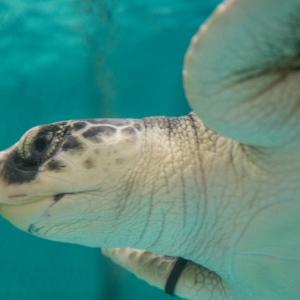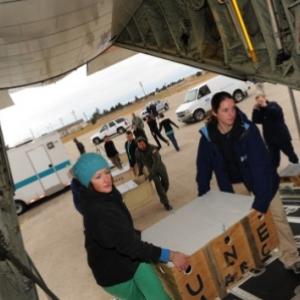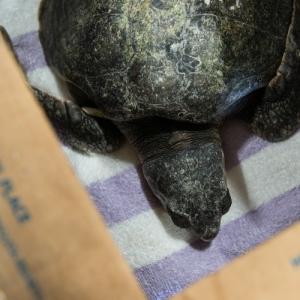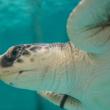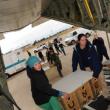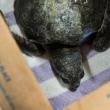Coast Guard Auxilary, volunteers help migrating turtles endangered by cold water of Cape Cod
 A recently rescued Kemp's Ridley turtle swims in a tank before being taken out and flown to Florida Thursday, Jan. 7. This turtle, along with 24 others, is being transported by the Coast Guard Auxiliary after they became stuck in the arm of Cape Cod on their way back down to warmer waters for the winter. (U.S. Coast Guard photo by Petty Officer 3rd Class Ross Ruddell)
A recently rescued Kemp's Ridley turtle swims in a tank before being taken out and flown to Florida Thursday, Jan. 7. This turtle, along with 24 others, is being transported by the Coast Guard Auxiliary after they became stuck in the arm of Cape Cod on their way back down to warmer waters for the winter. (U.S. Coast Guard photo by Petty Officer 3rd Class Ross Ruddell)
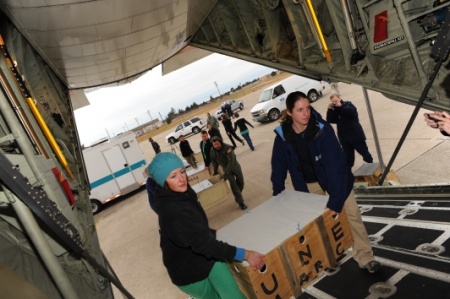 New England Aquarium volunteers and Coast Guard crew load up a Coast Guard C-130J in Coast Guard Air Station Cape Cod, Mass., with endangered sea turtles bound for recovery facilities in Orlando, Fla., Dec. 7, 2012. A record number of turtle 'cold strandings' in the Northeast coast prompted the emergency flight. The Coast Guard works with federal and state partners in times of need such as when animals are stranded or entangled. This joint effort involved close coordination with the following organizations and agencies: NOAA Fisheries Northeast Region Stranding Network, Florida Fish and Wildlife Conservation Commission, New England Aquarium, Sea World Orlando, Mote Marine Lab, Volusia Marine Science Center, Loggerhead Marinelife Center, and the Florida Aquarium. U.S. Coast Guard photo by Senior Chief Petty Officer Sarah B. Foster
New England Aquarium volunteers and Coast Guard crew load up a Coast Guard C-130J in Coast Guard Air Station Cape Cod, Mass., with endangered sea turtles bound for recovery facilities in Orlando, Fla., Dec. 7, 2012. A record number of turtle 'cold strandings' in the Northeast coast prompted the emergency flight. The Coast Guard works with federal and state partners in times of need such as when animals are stranded or entangled. This joint effort involved close coordination with the following organizations and agencies: NOAA Fisheries Northeast Region Stranding Network, Florida Fish and Wildlife Conservation Commission, New England Aquarium, Sea World Orlando, Mote Marine Lab, Volusia Marine Science Center, Loggerhead Marinelife Center, and the Florida Aquarium. U.S. Coast Guard photo by Senior Chief Petty Officer Sarah B. Foster
 A cold-stunned Kemp's ridley turtle sits in a warm box before his flight to Florida at Marshfield Airport, Thursday, Jan. 7, 2016. The sea turtle, along with 24 others, is being flown to Florida by members of the Coast Guard Auxiliary. (U.S. Coast Guard photo by Petty Officer 3rd Class Ross Ruddell)
A cold-stunned Kemp's ridley turtle sits in a warm box before his flight to Florida at Marshfield Airport, Thursday, Jan. 7, 2016. The sea turtle, along with 24 others, is being flown to Florida by members of the Coast Guard Auxiliary. (U.S. Coast Guard photo by Petty Officer 3rd Class Ross Ruddell)
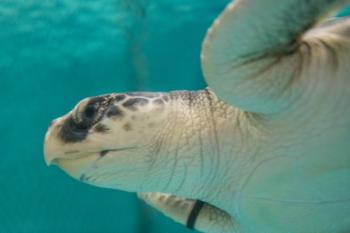 A recently rescued Kemp's Ridley turtle swims in a tank before being taken out and flown to Florida Thursday, Jan. 7. This turtle, along with 24 others, is being transported by the Coast Guard Auxiliary after they became stuck in the arm of Cape Cod on their way back down to warmer waters for the winter. (U.S. Coast Guard photo by Petty Officer 3rd Class Ross Ruddell)
A recently rescued Kemp's Ridley turtle swims in a tank before being taken out and flown to Florida Thursday, Jan. 7. This turtle, along with 24 others, is being transported by the Coast Guard Auxiliary after they became stuck in the arm of Cape Cod on their way back down to warmer waters for the winter. (U.S. Coast Guard photo by Petty Officer 3rd Class Ross Ruddell)
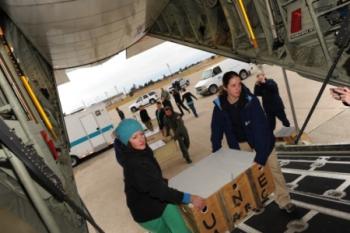 New England Aquarium volunteers and Coast Guard crew load up a Coast Guard C-130J in Coast Guard Air Station Cape Cod, Mass., with endangered sea turtles bound for recovery facilities in Orlando, Fla., Dec. 7, 2012. A record number of turtle 'cold strandings' in the Northeast coast prompted the emergency flight. The Coast Guard works with federal and state partners in times of need such as when animals are stranded or entangled. This joint effort involved close coordination with the following organizations and agencies: NOAA Fisheries Northeast Region Stranding Network, Florida Fish and Wildlife Conservation Commission, New England Aquarium, Sea World Orlando, Mote Marine Lab, Volusia Marine Science Center, Loggerhead Marinelife Center, and the Florida Aquarium. U.S. Coast Guard photo by Senior Chief Petty Officer Sarah B. Foster
New England Aquarium volunteers and Coast Guard crew load up a Coast Guard C-130J in Coast Guard Air Station Cape Cod, Mass., with endangered sea turtles bound for recovery facilities in Orlando, Fla., Dec. 7, 2012. A record number of turtle 'cold strandings' in the Northeast coast prompted the emergency flight. The Coast Guard works with federal and state partners in times of need such as when animals are stranded or entangled. This joint effort involved close coordination with the following organizations and agencies: NOAA Fisheries Northeast Region Stranding Network, Florida Fish and Wildlife Conservation Commission, New England Aquarium, Sea World Orlando, Mote Marine Lab, Volusia Marine Science Center, Loggerhead Marinelife Center, and the Florida Aquarium. U.S. Coast Guard photo by Senior Chief Petty Officer Sarah B. Foster
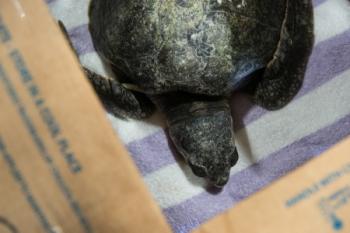 A cold-stunned Kemp's ridley turtle sits in a warm box before his flight to Florida at Marshfield Airport, Thursday, Jan. 7, 2016. The sea turtle, along with 24 others, is being flown to Florida by members of the Coast Guard Auxiliary. (U.S. Coast Guard photo by Petty Officer 3rd Class Ross Ruddell)
A cold-stunned Kemp's ridley turtle sits in a warm box before his flight to Florida at Marshfield Airport, Thursday, Jan. 7, 2016. The sea turtle, along with 24 others, is being flown to Florida by members of the Coast Guard Auxiliary. (U.S. Coast Guard photo by Petty Officer 3rd Class Ross Ruddell)
Without the help of the Coast Guard Auxiliary, the New England Aquarium, and the National Oceanic and Atmospheric Association, hundreds of the most endangered sea turtle species on the planet would die.
Every year, Kemp's Ridley Sea Turtles make the journey from their birthplace in the warm waters of Florida to the nutrient-rich waters off New England. The nearly 1,500 mile migration is vital to the turtles' survivability. The hatchlings spend the summer north of Cape Cod, feeding on fish, mollusks, crabs, and jellyfish. After the feast however, many turtles end up fighting for their lives.
From late summer into early fall the ocean water temperatures in the Northeast start to plummet. Instinctually, the smallest marine turtles in the world turn around and head south again.
The arm of Cape Cod, which juts into the Atlantic Ocean more than 200 miles, acts like a hook and traps some of the turtles.
During the fall, volunteers and staffmembers from the New England Aquarium and NOAA's Atlantic Regional Fisheries Office gathered dozens of turtles clinging to life on the beaches of Cape Cod. Some were barely alive, paralyzed by the cold water, most were almost unable to breathe. They needed to get warm, and get warm fast.
In keeping with the volunteering spirit, the Coast Guard Auxiliary answered the call for help.
The mission was critical — fly 25 cold-stunned turtles to Florida so they could be released back into the warmer water and survive. For Auxiliary pilots Steve Trupkin and Pete Lombardo, this mission was exactly what they joined the auxiliary to do.
“We're honored to work with our partners at NOAA and the New England Aquarium to ensure these turtles arrive safely in Florida,” said Trupkin.
However, it was more involved than a simple transport.
“Our most important issue with the turtles is keeping them between 68 and 75 degrees during the transport,” said Kate Sampson, a sea turtle stranding and disentanglement coordinator at the NOAA fisheries center.
Early on a morning in 2016, the freezing turtles were at the New England Aquarium's Quincy Facility getting ready for travel. They were placed into cardboard boxes, wrapped in fluffy towels, and given a heating pack for the ride. Once safely and securely packaged in boxes the turtles were driven to the Marshfield Airport for the final leg of their journey back home.
From the beaches, to the back of a car, to the front of the plane, the volunteers quickly loaded the tiny turtles so they could meet the strict 9 a.m.deadline
for wheels up.
With the turtles loaded up and wrapped in blankets, the two Coast Guard pilots shook hands and hastily boarded their plane, propellers spinning in the crisp winter air.
The volunteers, anticipating the takeoff, watched the small plane taxi down the runway. The pilots made an about-face and gunned the throttle. Cheers echoed through the hangars, and the team of turtle rescuers watched the plane become airborne and take the turtles south for the winter.
Event Date
Address
United States

